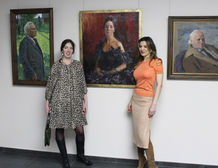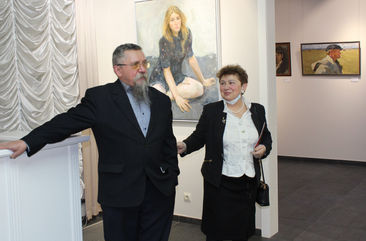top of page
One of the central problems of Russian fine art has always been the problem of personality as such. The subject world of still lifes and the natural world of landscapes were considered by Russian artists in the context of their inseparability from human life on earth, as important components of the "personal", surrounding and creating a person, even if he himself was absent from the image. Therefore, the portrait genre is the field of activity of masters, within which each new generation of artists solves the issues of the value of human life, and, whether it is a portrait or a self-portrait, makes attempts to measure their creativity with the world around them. Since the ancient Parsuns, interest in man in Russia has not faded, and could not fade until today.
The unified creative method of socialist realism, proclaimed in the 20s of the twentieth century, was a stylistically heterogeneous phenomenon that managed to combine a significant number of trends aimed at finding new expressive forms. Following the pictorial traditions of the Academy of Arts, which absorbed the achievements of Russian portrait painting of the late XIX - early XX century, is guessed in the works of B.V. Johanson and his outstanding students: A.P. Levitin, M.K. Kopyttseva, O.L. Lomakin, I.A. Razdrogin. These works reflect a characteristic trend where the realistic interpretation of the image is combined with the achievements of impressionistic painting. Special attention is paid to the works of A.P. Levitin and O.L. Lomakin, whose works have become high examples of Russian art of the 2nd half of the twentieth century in the genre of portrait.
The truthful intonation, the desire to capture the image of the person being portrayed in its naturalness and at the same time reveal the deep essence of the personality is also read in portraits by P.F. Alberti, A.A. Levitin, V.V. Nabatov, S.A. Ostrov, N.N. Repin, N.A. Sysoev, V.F. Tokarev, A.F. Tokareva. The development of the Russian psychological portrait continues in the works of the Moscow artists brothers A.P. and S.P. Tkachev. They boldly use a color that models the shape. Thanks to this, a voluminous pictorial texture is created on the canvas, which works to create a monumental character of the images.
Interest in the heritage of the Russian avant-garde and European modernism is clearly felt in the work of A.F. Pakhomov, resorting to conditional stylization characteristic of the 20s - 30s of the twentieth century.
The next generations of masters, represented by artists A.G. Vinogradova, K.V. Datsuk, V.R. Yezhakov, P.V. Eskov, I.K. Kapitonov, I.V. Lokhmatova, A.D. Lukashenko, V.A. Lyapkalo, A.V. Tyshchenko, V.V. Kharchenko, who are our contemporaries, have the opportunity to address in their work the broad layers of Russian and foreign artistic heritage. A special role in the works of Lukashenka is given to the symbolism of color; the artists Vinogradov, Yezhakov, Eskov, Lyapkalo create vivid direct images of contemporaries. In the portraits of the work of Tyshchenko and Lokhmatova, the actual expressive interpretation is combined with a coloristic system, in which one feels a tribute to the work of outstanding painters of the early twentieth century.
The exhibited graphic works by A.P. Levitin, O.L. Lomakin, N.N. Galakhov, I.A. Razdrogin, V.V. Nabatov, P.F. Alberti and contemporary artists A.G. Vinogradova and K.V. Datsuk give a complete picture of the best examples of studying nature within the framework of academic drawing.
The viewer will get a different idea of the development of Russian graphics of the 2nd half of the twentieth century by examining the works of outstanding masters A.Z. Davydov, K.A. Klementyeva, G.M. Nemenova. Directly inheriting the graphic traditions of the world-artists and avant-gardists, these artists, each in their own way, create a kind of conditional world, do not follow the path of creating a psychological portrait, but develop the concept of a portrait-sign, where the characteristic of the depicted model is accurately noticed, a certain concentrated image of the most striking and recognizable personality traits is given. So, at the turn of the 80s - 90s, when Russian society was in search of a modern hero, A.Z. Davydov performs a whole galaxy of memorial portraits in the technique of lithography. Masterfully using the techniques of flat engraving, the artist presents images of artists as some kind of opus-reflections on the fate of Russian culture. Deliberately limiting the means of expression, the outstanding graphic artist G.M. Nemenova creates the image of N.V. Gogol, who has become an internationally recognizable symbol of the writer's appearance.
The works presented in the exhibition, despite their relatively small number, largely make it possible to trace the development of the national portrait since the middle of the twentieth century. It is in this field of fine art, which follows the path of traditional Russian painting and graphics, without abandoning the subject image, the portrait genre continues to be actively developed by modern masters, exploring the phenomenon of human personality.
The exhibition will run until the end of April from 11.00 to 20.00, except Monday and Tuesday
bottom of page


















